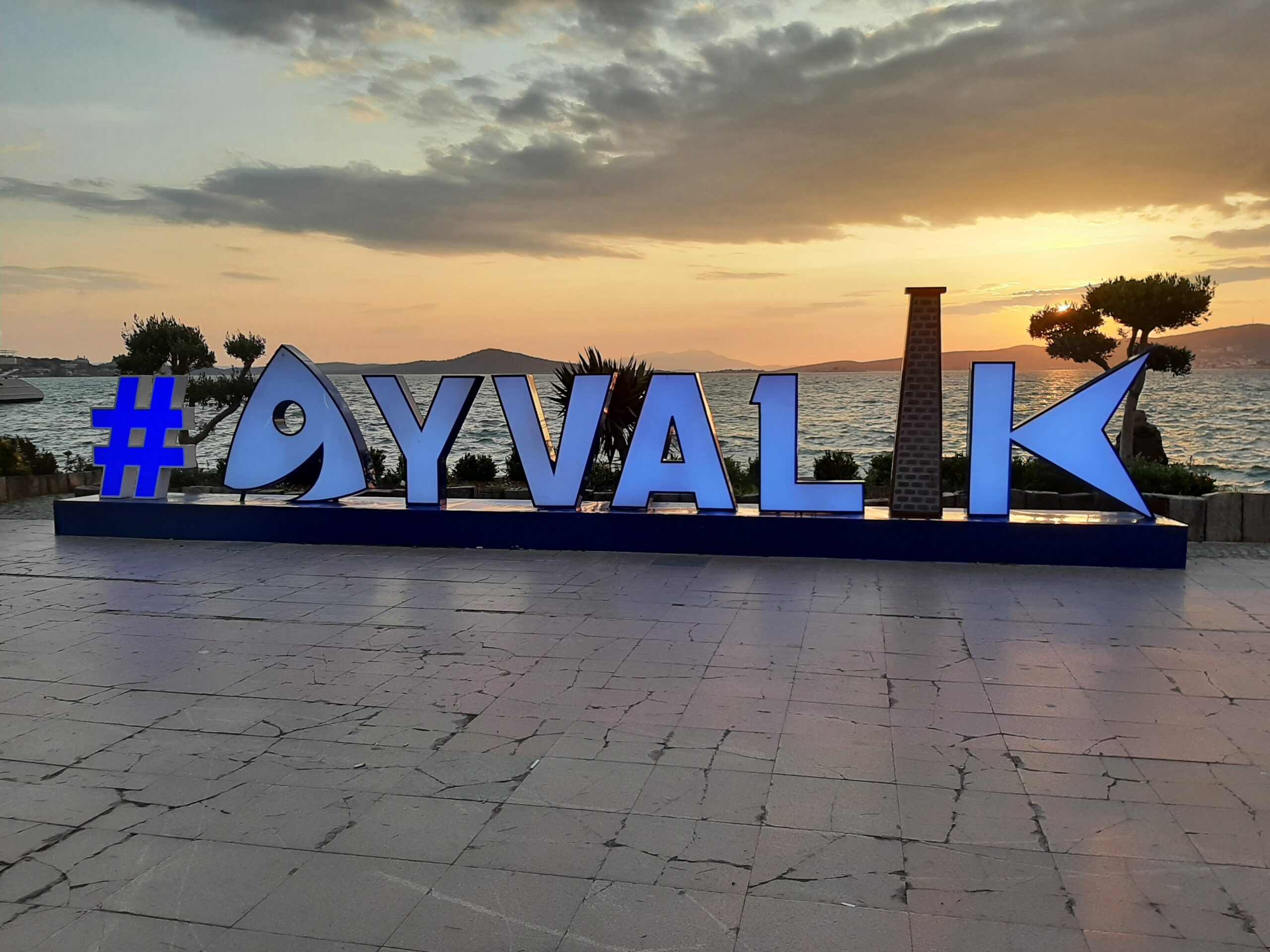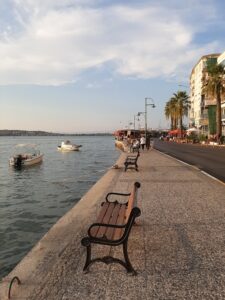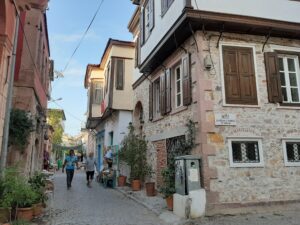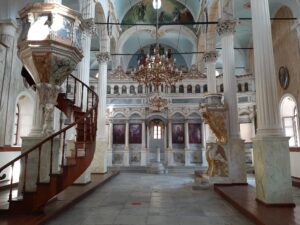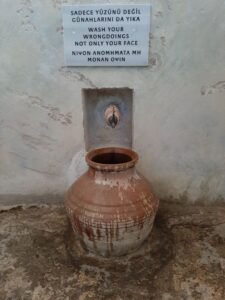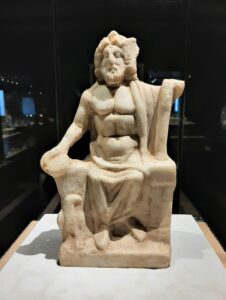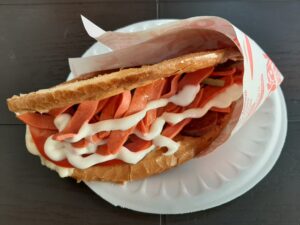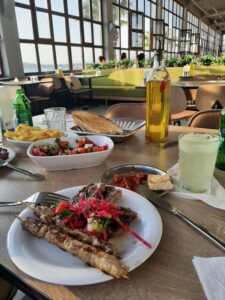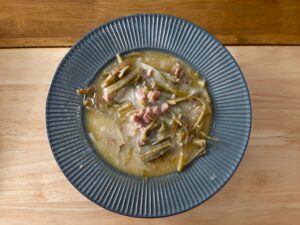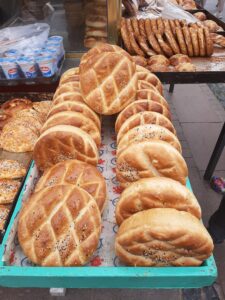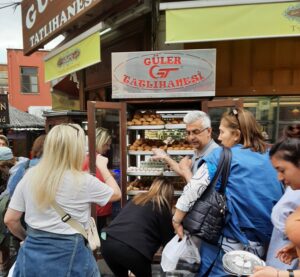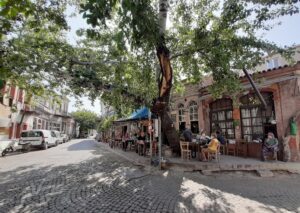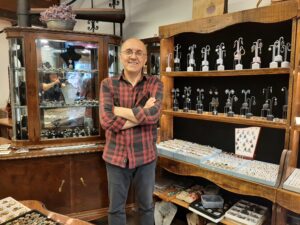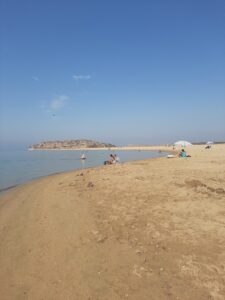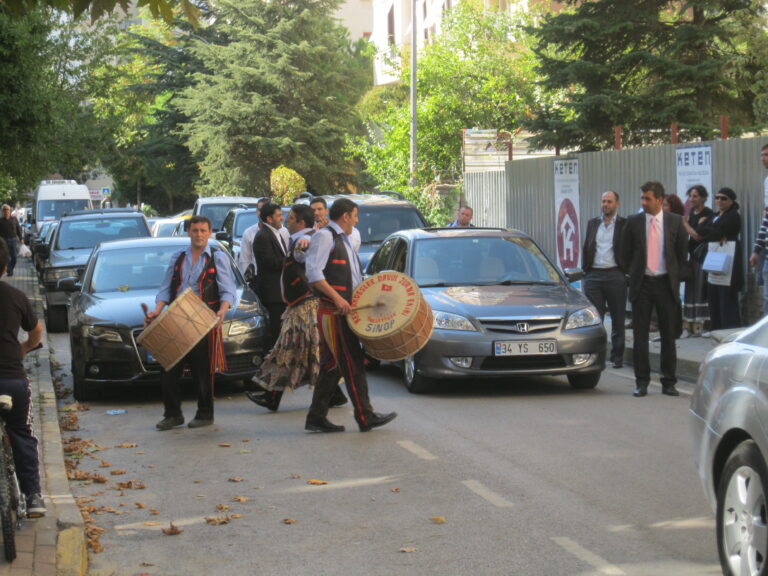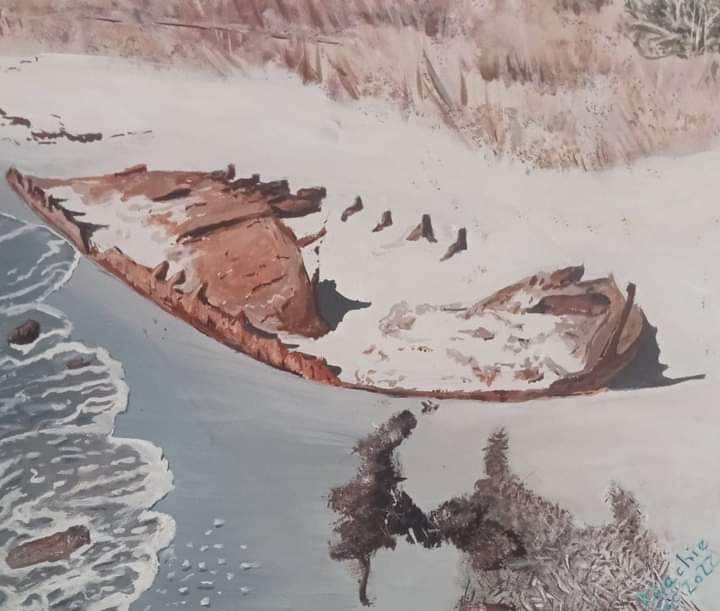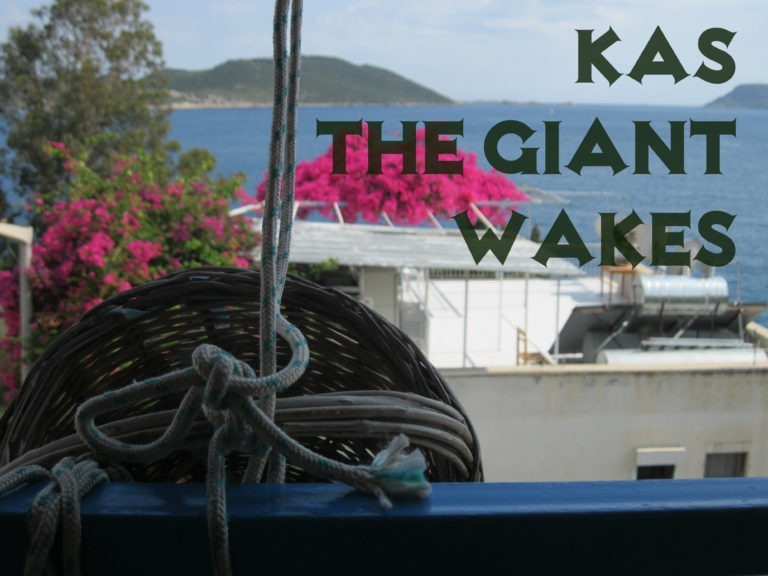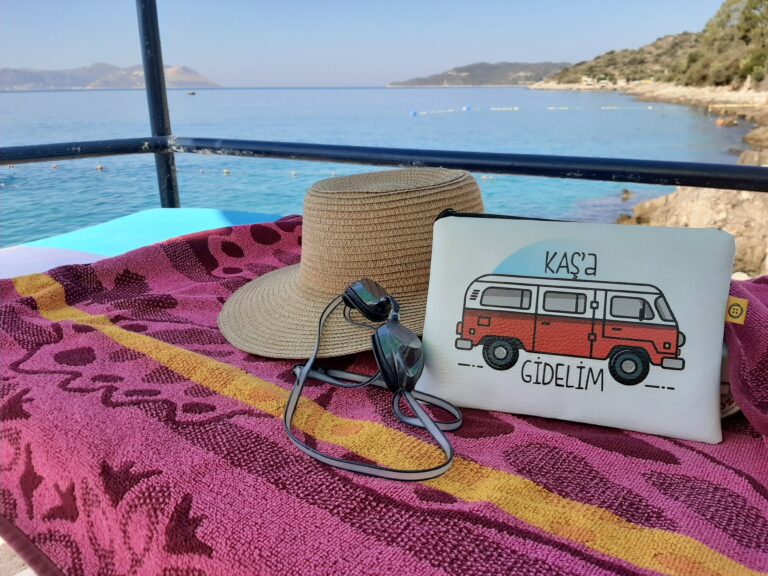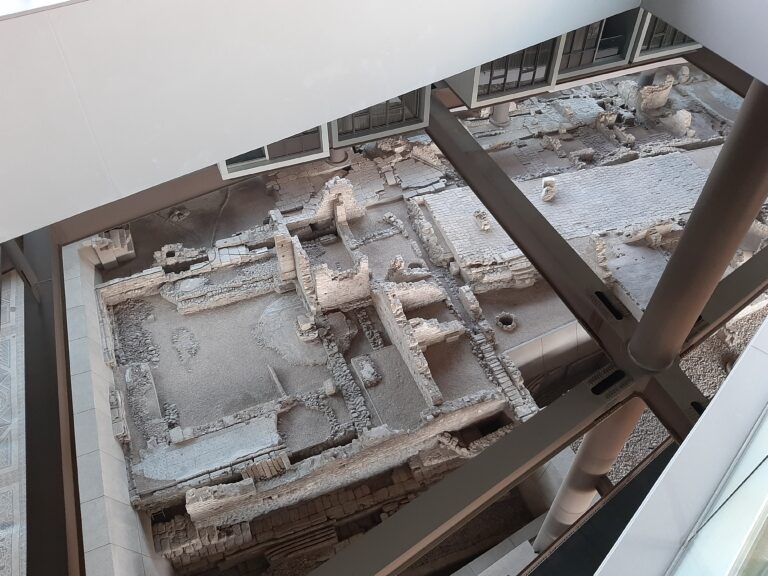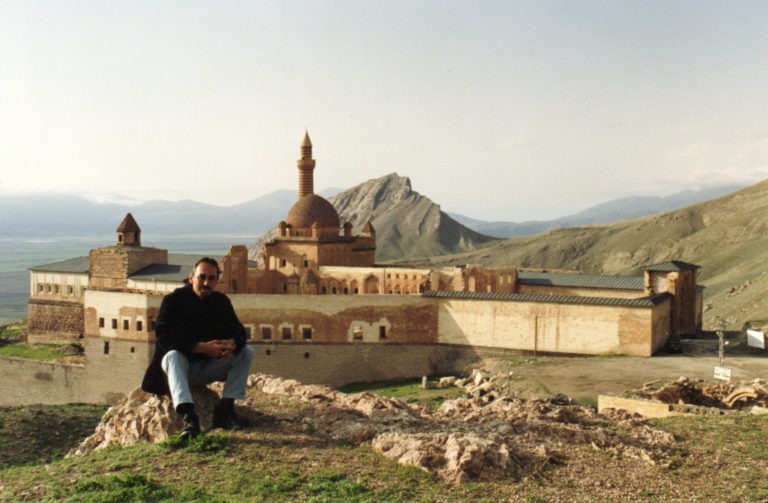Ayvalik – What to see and do
The first time I went to Ayvalik was in August 2020. It was stinking hot, madly crowded with holidaymakers despite being under COVID conditions, and I really didn’t get what people saw in the place. It hadn’t helped that my hotel of choice cancelled my booking, forcing me to choose another option which turned out to be dark and dingy rather than quaint and characterful as the photos and description suggested.
Before I went to Ayvalik again, twice in 2023, I pulled up my big girl travel writer pants, researched everything it was possible to see and do on foot or by public transport (you know me, I don’t drive) and then led, followed and cajoled my darling husband Kim to come with me through the town centre, along hiking trails on Cunda island, share plates of delicious food and generally explore the area properly. I’m pleased to say I generally liked what I saw and have used my experiences from these three different trips to write this guide for you. You’ll find all the practical stuff like how to get there and so on, at the end of the post.
AYVALIK HISTORY
When you stand on the waterfront in Ayvalik, a seaside town on the Aegean coast of Turkey, you can see Midilli, Lesbos, 22 nautical miles away over in Greece. In contemporary Greek the town was known as Kidoniyes, but the Ottomans renamed it Ayvalık, meaning quince orchard.
Until the early 20th century Ayvalik had a large Greek population, greatly outnumbering the Turks who lived there, and was a culturally rich and powerful port city. Locals grew and traded olives and olive products such as oil and soap, for which they’re still famous. They were also known for the leather products they made.
AYVALIK TOWN CENTRE
The town centre takes in a number of different neighbourhoods, with narrow streets full of historic houses. They’re made from Sarımsaklı stone, a type of volcanic tuff quarried from the Sarımsaklı Peninsula, Many have the date they were erected inscribed on the stone lintels, with elegantly carved door and window frames, elaborate door knockers and wooden interiors in neo-classical style. There are about 3800 houses under the protection of the Council of Monuments, including churches, olive oil, soap and leather making buildings. Some specific streets to look out are Cumhuriyet, Ismet Paşa and Mareşal Fevzi Çakmak as well as 13 Nisan Caddesi.
The town spreads inland from the water up the hill, and many of the streets run perpendicular to the waterfront, enabling cooling breezes to blow up into town. This layout also means it’s easy to head straight to the water.
Atatürk Heykel Meydanı, the small square right on the water with its Ataturk statue, ringed by moored boats and bustling cafes is a popular meeting spot for locals, and a good place to start your wandering. As long as you know how to get back to it you’re unlikely to get lost, although getting lost in the backstreets of Ayvalik is part of the fun. The PTT (post office) is another handy location marker. Now you know where you are, here are my suggestions.
WHAT TO SEE
Stroll down Talatpaşa Caddesi, the pedestrianised street off Atatürk Bulvarı packed with small shops selling local specialty sweets (more on this later), cheese and clothes as well as restaurants and cafes.
Çınarlı Camii (Hagios Georgios Church) – Alibey Cami Cad
The plane tree mosque was originally a church built in the form of Greek cross in the 1790s. It was converted into mosque in 1923 when the muezzin loft and mihrab were added.
Taksiyarhis Kilise ve Müzesi – Mareşal Fevzi Çakmak Cad, 11 Sok
According to historians, in the 15th century a church was built on this site but no trace of this earliest structure remains. Late in the next century local Greeks started construction of the Taksiyarhis church on the same spot, completing it early in the 17th century. It was further enlarged in 1753 and rebuilt in 1844 as the Archbishopric Church. Today, the rather plain exterior gives little inkling of what you’ll see when you enter. The current interior contains icons showing the life story of Jesus, and a neo-classical style fresco of Paul and Peter presenting the building to God. Some of these images were painted over earlier frescoes that were damaged by successive earthquakes. After the Turkish War of Independence the church was used as a depot, then restored by the Ministry of Culture and Tourism in 2012. It opened as museum in 2013.
Open 7 days a week, 8.30-19.00, 80tl entry fee*
Saatli Camii (Hagios Ioannis Church) – Çarşı Sok, inland from the PTT
Named for its bell tower with clock, this building was originally the Greek Agios Yannis Church dating to 1870. In 1928, after the population exchange, it was converted into a mosque and the frescoes were whitewashed away. A minaret was added later.
Macaron Mahallesi (streets in and around Barbaros Caddesi)
The Macaron neighbourhood is one of oldest areas in Ayvalik. In the past macaron, a plant that comes from the thyme family, was grown here. The word can also mean ‘the smell of coffee’ and relates to the Cretan Greeks, moved here during the population exchange who would put it in their coffee. Macaron is a great area to wander in, full of narrow streets packed with neo-Classical stone houses 100 to 150 years old. In particular look out for Macaron Konağı on 13 Nisan Cad 18 Sok, off Barbaros.
Ayvalık Ayazması (Panagia Phaneromeni Hagiasma) – Merkez Hastane Cad 7, Sok No 22
Dating to 1890, the Holy Water Church is Neo-classical in style and made from Sarımsaklı stone, but resembles a Greek temple with an architrave and triangular pediment on four Corinthian-type columns at the entrance. Over time, a mezzanine floor was added and used for different purposes, such as an olive oil factory and a tobacco warehouse. It’s covered with a gable roof and there are plaster flower reliefs in the centre of each of the square sections of the roof.
According to legend, Panagia, Mother Mary, appeared to a young girl in a dream, drinking water bubbling out of otherwise empty land. The little girl told her parents and said Mary also gave her water to drink. They consulted with the priests who ordered a well be dug on the spot the girl saw in her dream. When water gushed out they believed it to be a holy water source, hagiasma in Greek and ayzazma in Turkish, so a church was built on the site. You can still access the ayazma today, but take note of the message above it.
NORTH OF TOWN CENTRE
Sezai Ömer Madra Tarihi Zeytinyağı ve Sabun Fabrikası
At the north end of the main road you’ll see a grand run down building on the seaside. It’s the Sezai Ömer Madra Historical Olive Oil and Soap Factory. Sezai Ömer Bey came from a family that produced and traded olive oil for generations. He left his birthplace of Lesbos in 1917 and started trading olive oil and soap at the Yağ İskelesi in Istanbul. After serving as a member of the Istanbul Chamber of Industry and Commerce for many years he eventually settled in Ayvalık, growing olives and his family. Sezai Ömer Bey died in 1950 but his legacy continues through his grandchildren Salih and Sezai Madra who produce a boutique olive oil brand using olives from their own groves in Ayvalik. The building is currently empty but even just viewing it from the outside gives you good idea of what this neighbourhood, Sakarya, would have been like when it was full of olive oil and soap factories.
Ayvalik Anadolu Uygarlıkları Sergisis– Atatürk Bülvarı (behind the Kırlangıç AVM – Shopping Centre)
Tucked away in a rather modern shopping centre that incorporates repurposed factory buildings, the small Ayvalik Exhibition of Anatolian Civilizations packs a real punch. 619 artefacts from the Chalcolithic Age right through to the Byzantine period are displayed on the first floor.
Open Tue-Sun, 9.00-17.00, closed Mondays. Entry price 10tl (I’m waiting for an update).
DINNER & LIGHT MEALS
Ayvalık is famous for papalina, a small fish officially known as a sprat. It’s similar in appearance to a sardine and is usually grilled and served with a selection of greens.. Meyhane, restaurants serving alcohol and meals are also very popular around town. They display daily selections of seafood meze in glass fronted fridges including prawns, calamari, lakerda (bonito) and octopus, alongside smoked, fried and vegetable meze all of which are served either hot or cold. Unfortunately I can’t recommend anywhere specialising in fish and seafood, for various reasons. Some of them are lacking in hygiene, others are so indoor outdoor there’s cigarette smoke everywhere but the biggest issue is price. Turkish friends who live in Ayvalik and others with holiday homes say they no longer eat fish and seafood in town or on Cunda Island, because it’s just too expensive. I’ll leave it for you to decide for yourselves but a word of advice – check/ask the price of EVERYTHING you order, especially food items like fish and seafood that are priced according to weight.
Don’t worry though, there are plenty of other options for all budgets.
Saray Pide on Talatpaşa Caddesi is run by very friendly people including a man who worked in Sultanahmet as a köfte chef between 1981-1995. They serve up tasty chicken döner on tombik (a squishy round bread roll) for take away or eat in at their outdoor tables and benches.
Saraybosna Grill on Gumruk Caddesi is a family run business serving up good food, both in terms of taste (their specialty köfte are something else) and value for money. As well as serving different köfte meals they have a selection of dishes in a bain maire that change daily. Even though I always start the meal saying I absolutely won’t have dessert, it’s very hard to resist their freshly made sutlaç (rice pudding) and sweet pastries. You can find out more about Ayvalık’s Balkan population in my entry on Küçükköy in a separate post coming soon.
As the name suggests, Tostçular Çarşısı on Atatürk Bulvarı No 122 sells toast. Not just any toast though. They serve up the famous Ayvalık Tost, a combination of tomato salça, slices of spicey sucuk (spicey Turkish sausage), some salami, yellow cheese, turşu, of the pickled cucumber variety, margarine or butter, ketchup and mayonnaise. I personally don’t see their appeal but think the smaller and cleaner revamped enclosed interior, which means it’s officially no smoking now, is much more comfortable than the old one. According to a local friend of mine, genuine Ayvalik toast is served on ekşi nohut ekmeği (sour dough bread made from chickpeas), available at a café off Atatürk Heykel Meydanı. And no, before you ask, unfortunately I didn’t catch the name.
Köfteci Yusuf – Atatürk Bulvarı No 100A
Köfteci Yusuf in Ayvalik is part of a Turkey wide chain based on the concept of a restaurant adjacent/attached to a butcher, ensuring quality meat at reasonable prices. They offer grilled lamb and beef, köfte of course, hamburgers, soup, salads and sauces and basically everything you order off the menu is available to buy at the cash desk or their butchery. The Ayvalik branch is a stand out. It’s located in a former factory with chic industrial windows that open to catch the breeze and a young smiling team eager to serve.
Tamam Meyhane Barbaros Caddesi No 9, Sokak No 7
I am not a big fan of meyhane but I did enjoy a beer here with a friend. The courtyard is very pretty and the staff are warm and welcoming.
LUNCH ONLY
Firat Esnaf Lokantasi – Cumhuriyet Cad No 1 Sok
This traditional workman’s café is run by Nihat, a genial man serving up extremely tasty food for great prices. Fans of yoghurt should ask for a serve of the mandira, creamy and thick with goodness. If you’re on holiday from Istanbul ask Nihat if he has any olive oil for sale. It’s very good.
Paşşalı Müdavim Çorba – Cami Sok No 7
Just around the corner from Nihat’s place is Paşşalı Müdavim. As the word çorba suggests, they serve up delicious soups like mercimek (lentil) but also have changing daily specials such as lamb mixed with local greens, chicken saute and much more. If you usually have a snack at lunchtime and a big dinner at night I suggest you reverse the trend and lunch here. Come with an appetite and then maybe factor in an afternoon nap.
SWEETS & COFFEE
Each time I’m in Ayvalik I head straight to the corner of Atatürk Bulvarı and Talatpaşa Caddesi to the stall selling peksimet, a type of local bread, alongside a great range of lush açma, simit and poğaça. Don’t leave it too late because they usually sell out by mid-afternoon. Elsewhere in town look out for firin, that’s bakeries, selling fresh from the oven nohut maya ekmeği, bread made using chickpea yeast.
As well as olives, Ayvalik is known for sweet biscuits and desserts made with lor. Lor is a type of crumbly white cheese produced from the whey that forms while producing kaşar, a medium-to-hard Turkish pale yellow sheep’s cheese. Lor has a slightly dry texture and contains little salt, making it perfect for use in, well you name it. There’s Lor kurabiyesi, moist little biscuits, Lor tatlisi, a chewy spongelike cake drowning in syrup that is less painfully sweet than it looks and other lor treats I didn’t have room for. I probably shouldn’t have said yes when they asked if I wanted sakızlı dondurma (mastic ice cream) with my servings, but I wouldn’t be a proper researcher if I didn’t try everything at least once. OK, I’ll be honest I tried them (more than) a few times. Here are two places you can try lor selections for yourself;
Güler Tatlıhanesi – Talatpaşa Cad No 34
Güler are famous for their lor kurabiyesi and lor tatlisi paired with sakızlı dondurma and tea. They use ash juice instead of baking soda and grape juice instead of sugar in cookies. On weekends hoards of Turkish tourists come for flying visits and strip the outside tables and cabinets full of sweets bare. Their enthusiasm is admirable but they remind me of a flock of well-dressed locusts.
Imren Patisserie – Talatpaşa Cad No 45
A few doors along, Imren also serve freshly made curd biscuits and desserts with mastic ice cream.
Şeytan Kahvesi – 13 Nisan Cad No 2 (closes at 8pm)
Satan’s Coffee House is an Ayvalık institution. It’s housed in a building erected in 1865 but has only been run as a coffee house since 1950. According to owner Suat Kaçak, it gets its name from tales about his grandfather Halil, by all accounts a very naughty little boy. Halil originally came from Lesbos with his family during the Greek population exchange and settled in Ayvalık.
Apparently he used to hide behind a stone wall and throw pebbles at Greek women cooking pancakes on an open fire. At first they couldn’t work out who it was, but eventually they caught him out, and gave him the name Satan Halil.
Suat’s brother tells it differently. He says “When the devil was expelled, he first came to our café”. Interestingly, the Greek name for this café translates as ‘red apple’, so possibly there’s a backstory concerning Adam and Eve here. Either way, everyone can direct you to Şeytan Kahvesi.
It’s located in a lovely shady spot under huge tree but sometimes the noise from passing motorbikes is a nightmare. Also, they film Uç Kiz Kardesler in the shop next door over the winter months so there’s a chance you’ll be told to move tables or be quiet, or even stopped from walking past while they’re filming. Nonetheless it’s a great place to people watch especially around 5 o’clock-ish on a Friday and 9am on Mondays when the national anthem is played over the loudspeakers. The majority of people out and about stop and stand to attention until it finishes.
Coffee is a staple beverage here but on hot days, opt for the koruk suyu, otherwise known as verjuice, a type of unripened grape juice.
Crow Coffee Roastery – Cumhuriyet Cad No 218
This very stylish café selling single source Arabica makes coffee that tastes as divine as it smells. The staff are nice and given its edge of town location, is a good place to chill and recharge.
We checked out a lot of different places in Ayvalik for meals and coffee, but unfortunately smoking was an issue at many of them. In some people were outright smoking indoors, while others were so small the inside area opened onto the outside section so cigarette smoke permeated the interior. This is a problem everywhere in Turkey and I for one would like to see it change. As has been the experience elsewhere, create an outdoor non-smoking section and the people will still come. Trust me.
WHAT TO BUY
Ayvalik has a reputation of attracting intellectuals from Istanbul and Ankara, seeking an alternative lifestyle. A lot of the fashion in the shops reflects this, the natural fibre draped hippy vogue style I love, but which make me look like I’m wearing a sack. If you’re taller than five foot two and a quarter, you’ll be in clothing heaven.
I am late to the party when it comes to cheese, having only recently developed a taste for more than a basic English cheddar. On our most recent trip we came back with Ayvalik Tulum, a strong while cow cheese and Bergama Tulum, another strong cheese made from goat’s milk. Priced at half what they’d cost in Istanbul, I wish I’d come back with twice as much.
Even if you live in Turkey already, the Ayvalik Perşembe Pazarı (Thursday markets) should be on your itinerary. Every week farmers from outlying villages set up stalls and sell fruit, veg, cheese, sucuk, kuruyemiş (nuts and dried nibblies), herbs, spices and bal, honey. I love honey. My earliest memory is being around four years old and sitting on a high stool eating a slice of Vienna loaf dripping with honey. Literally. I got it on my knees but I didn’t care. In Ayvalik I prefer to buy from the lovely smiley village women in their colourful scarves and floral şalvar (gathered pants). Since cutting right back on sugar the çiçek bal (flower) is too sweet for me but the çamlı bal (pine), with its woody, deep flavour, is divine.
Cunda Taki – Barbaros Caddesi No 73
Despite the name you’ll find this boutique jewellery story at Barbaros Cad No 73, in town. I bought lovely silver earrings here from Polat Bey and was severely tempted by the unusual rings made by Armenian master jewellers. A former Istanbul resident who moved to Ayvalik about 14 years ago, Polat is friendly and knowledgeable about Ayvalik and sells a great range of quality silver items so it’s well worth popping in if you’re after a treat for yourself or a special present for a friend.
Çöp-madam – 13 Nisan Cade 14 Ikinci Sok, next to Seytan Kahvesi)
In Turkish, “çöp” means “garbage” and “madam” means the same as the French word we use in English. “Çöp(m)adam” translates literally as Garbage Ladies, and the women here take unwanted factory offcuts and the like, turning them into something fashionable and fun. When you buy something from them, you’re also giving back to the community. Read more about this here.
Open Mon-Sat, 09:00-17:30, closed Sundays.
BEACHES & SWIMMING
Sarımsaklı Beach is one of the most popular beaches in the area, but for my taste it’s too built up and not particularly appealing. Come summer the wide swathe of sand is wall to wall Turkish families while out of season it has that abandoned, end of season feel. I much preferred Baduvat Plaji. It does get busy in summer but away from the built up end the beach stretches along the coast like a narrow spit, lined with low sandy hillocks topped with scrub. To get here catch the Sarımsaklı minibus that trundles along Atatürk Bulvarı in the direction of the marina. Badavut is the last stop.
During the warmer months there are daily boat trips around the Ayvalik archipelago. Some have loud pop music going all day while others are quiet(er). You can opt for an all-inclusive with lunch (usually papalina) or bring your own food, but the majority expect you to buy refreshments on board. Boats depart at 10am, returning around 6 or 7pm.
Find out how to venture further afield to Cunda Island, Küçükköy and Şeytan Sofrası, without a car.
WHEN TO VISIT
I love to swim but having gone into the water once in May and come out shivering I can attest to the fact the water is more than a tad nippy. However spring is a good time to enjoy walks along the water and in nearby national parks. In August Ayvalik feels like every Turkish person ever, from everywhere around the country and beyond, has descended on the town. Whole neighbourhoods are given over to summer houses and there are hundreds of hotels so it’s jam packed. When I visited in October 2023 the temperatures were almost summer like. As Ayvalik is a working town rather than a holiday resort, there are plenty of shops to browse in and cafes and restaurants to choose from whatever the time of year. That said I’d give it a miss in winter mainly because of the rain.
GETTING TO AYVALIK FROM ISTANBUL
I’m a big fan of Turkey’s well-developed intercity bus routes so if you have/rent a car I can’t help with directions but here are some things to know before you decide to drive in Turkey. Travelling by bus is a great option as there are dozens of companies heading wherever you want to go. You can buy tickets direct from their offices but I use the Obilet app. It’s really convenient but best of all, if you have a problem (like when they change the bus model and you don’t like the new seats they’ve allocated you) they have an English speaking option. The staff are well trained, easy to understand and good at problem solving. Check out my Practical Intercity Bus Travel in Turkey Guide for everything you need to know.
Depending on the bus company you choose, the trip from the Asian side of Istanbul to the Ayvalık Otogar takes between 6 and 7 hours. You can also fly to Balikesir Koca Seyit Airport with Pegasus Airlines from Sabiha Gökçen Airport and catch a shuttle bus from there to Ayvalik Otogar. The shuttle runs twice a day, takes about 40 minutes and costs 144tl. When I’m looking for a flight I use Kiwi.com.
Whichever way you travel, from the otogar, the bus station, you’ll need to catch a minibus/dolmuş into town for 13tl. The trip can take up to 30 minutes, depending on the traffic. Here’s the timetable for the service.
If you plan to visit all the places I mention in this piece using public transport, I recommend you buy a Balkart. The machine at the Otogar didn’t work but you can get a card at a booth located near the Lesbos ferry wharf or the one in the main square. It costs 15tl for the card then you load it with money to cover however many trips you want to take. You can use the same card for more than one person so it’s very convenient. You can find more information about Ayvalik public transport here.
If getting a card doesn’t seem worthwhile you can always pay cash on the minibus/dolmuş, but it will cost you a bit more. There are also yellow city buses going set routes, stopping only at bus stops, but they tend to have a limited number of services per day. They accept the Balkart, Turkish bank cards and sometimes cash.
WHERE TO STAY
A lot of people like to stay on Cunda but out of season the island offers fewer options for meals, and in season the hotels and restaurants are considerably more expensive than in Ayvalık itself. As I already mentioned, Ayvalık in general is a very popular destination for Turks in summer as well as on weekends in spring and autumn, so don’t expect to rock up without booking in advance, especially if you’re after something out of the ordinary or good value for money. When I want to find a place to stay I use Booking.com.
AYVALIK TOURIST OFFICE
Sefa Çamlık Mahallesi İnönü Caddesi Kaktüs Sokak No 11
For reasons best known to the powers that be, the Tourist Office is located past the marina, on the road to Sarmısaklı beach. Basically, it’s not near any of the sites you’re likely to want to see which is a shame because they have a great selection of brochures about Ayvalik and the surrounding areas, in a variety of languages.
*****************
Here are some other helpful tips for planning your trip to Turkey
Don’t pay extra for an E-VISA. Here’s my post on everything to know before you take off.
However E-SIM are the way to go to stay connected with a local phone number and mobile data on the go. Airalo is easy to use and affordable.
Even if I never claim on it, I always take out TRAVEL INSURANCE. I recommend Visitors Coverage.
If you’re travelling alone, check out this post on useful solo travel tips Turkey for women (and men).
I’m a big advocate of public transport, but know it’s not suitable for everyone all the time. Whenever I need to be picked up from or get to Istanbul Airport or Sabiha Gokcen Airport, I use one of these GetYourGuide website AIRPORT TRANSFERS.
*****************
*All prices correct as of date this post was published but this being Turkey, things change, so make sure you budget for higher costs, just in case.
